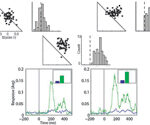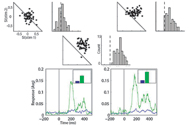Stimulus Specific adaptation and target selection
 Stimulus specific adaptation (SSA) is a phenomenon at the neural level, proposed as the neural correlate of novelty detection. In SSA a rare stimulus elicits a stronger response than a frequent stimulus. Novelty is an important component of stimulus saliency and has been linked with the ability of animals to abruptly attend to events that differ from their background. Because of its assumed importance in target selection the phenomenon of SSA has recently attracted much scientific attention. We have measured and analyzed responses of neurons, in three different brain regions, to probabilistic stimuli which were specifically designed to probe SSA. Our findings robust SSA in high brain areas related to decision and gaze control (the optic tectum and the frontal eye fields) but not in low sensory areas (the inferior colliculus). Remarkably, we have demonstrated similar SSA to four independent acoustic features (sound frequency, the two binaural localization cues and sound intensity) and one visual feature (spatial position). This is in contrast to most previous studies, which have focused on one sensory feature at a time. The manifestation of the SSA in such a wide variety of features supports the notion that the SSA in the gaze control centers is involved in sensory memory for novelty detection. Currently we are analyzing SSA to bimodal visual-auditory stimuli. Stimulus specific adaptation (SSA) is a phenomenon at the neural level, proposed as the neural correlate of novelty detection. In SSA a rare stimulus elicits a stronger response than a frequent stimulus. Novelty is an important component of stimulus saliency and has been linked with the ability of animals to abruptly attend to events that differ from their background. Because of its assumed importance in target selection the phenomenon of SSA has recently attracted much scientific attention. We have measured and analyzed responses of neurons, in three different brain regions, to probabilistic stimuli which were specifically designed to probe SSA. Our findings robust SSA in high brain areas related to decision and gaze control (the optic tectum and the frontal eye fields) but not in low sensory areas (the inferior colliculus). Remarkably, we have demonstrated similar SSA to four independent acoustic features (sound frequency, the two binaural localization cues and sound intensity) and one visual feature (spatial position). This is in contrast to most previous studies, which have focused on one sensory feature at a time. The manifestation of the SSA in such a wide variety of features supports the notion that the SSA in the gaze control centers is involved in sensory memory for novelty detection. Currently we are analyzing SSA to bimodal visual-auditory stimuli.
Project Leader: Amit RechesRelated articles: |
